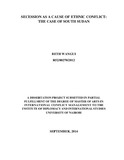| dc.description.abstract | Secession is an attempt to resolve a domestically based territorial dispute by dividing a
country's home- land territory into new, secessionist and rump. the World has experienced
secessionist movements from the including the latest case in Africa, the Sudan. Nationalism
and self determination is a modern phenomenon not only in Africa but also in the world,
such as the United Kingdom case of Scotland wanting to secede. However, the process of
secession is often one that is conflictual in nature as many states are not willing to give up
part of their territory. Additionally, secessionism may not resolve the original dispute to the
states' satisfaction. In the aftermath of a secession, the leader of the rump state is motivated
to use force by the benefits of retaking (some of) the land lost to the secessionist state, while
the secessionist state's leader is motivated by the benefits of acquiring even more land. The
objectives of the study are to examine and analyze secession as cause of conflict, how
ethnicity and secessionism are linked, the challenges involved that implicate on the national
and regional security. To achieve these objectives the study will employ research
methodology of content analysis with an emphasis of the Sudan secessionism. The study uses
theories of nationalism and ethnicity to explain the reasons why ‘nations’ secede. Some of
the findings of the study are that the peaceful versus violent secession process affects
whether these desires escalate into the violent conflict while peaceful secessions lead to
peaceful relations. However the study also notes of the emerging issue of redrawing of the
African states boundaries that were previously set by colonialists, noting of the new
possibilities of more future secessionist movements. | en_US |

